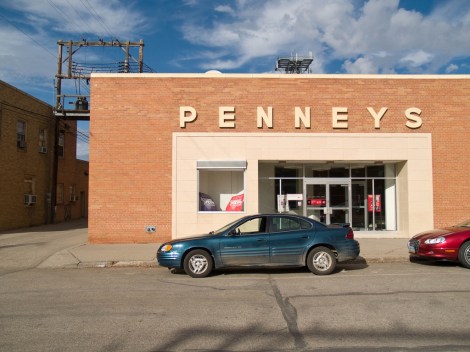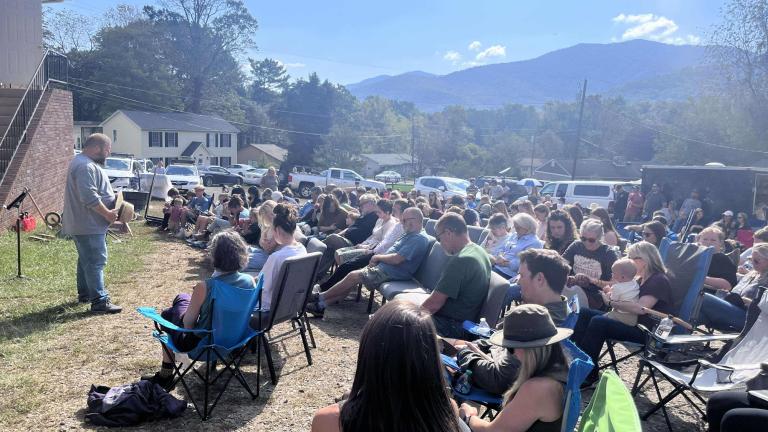It really is an apt image: a series of briefcases, presumably in a range of colors from dusty brown to black, sitting in the freezing air on the steps of a North Dakota courthouse sometime before dawn. The briefcases served as proxies for the oil and gas company representatives jostling to buy mineral rights in the empty flatness of western North Dakota, representatives not eager enough to close the deals that they would stand in subzero temperatures.
This scene leads the New York Times Magazine’s overview of the state’s newest-but-not-only oil boom, the cacophonous hustle to split apart the Bakken shale with hydraulic fracturing. The Times has been on a North Dakota bender of late, covering gender issues and infrastructural strains caused by the boom. But this most recent piece provides the most insight on how the boom came to be and how long it might last.
They have been through this before, the people of North Dakota, first in the ’60s, a decade after oil was discovered in the state. And then again in the late ’70s, when the boom was driven by rising oil prices. Monthly oil production, which peaked in 1984 at 4.6 million barrels, fell to half and then went sideways for nearly a quarter-century. By February 1999, there wasn’t a single rig drilling new wells in the state, and oil development looked to be yet another cautionary tale in the familiar boom-and-bust history of the region …
And then around seven years ago — driven by technological refinements that have made North Dakota a premier laboratory for coaxing oil from stingy rocks — the state’s Bakken boom began in Mountrail County. … The first areas of the Bakken to be hydraulically fractured were on the Montana side of the Williston Basin in the Elm Coulee Field, where oil was discovered in 2000. Early treatments there were called “Hail Mary fracks” because geologists and engineers would just drill a well, pump in frack fluid and pray for a robust result. The technique is more exact now. Certain grades of sand or sometimes proppant made of ceramic beads are matched to certain kinds of rock, and the wells are fracked in stages, as many as 40 stages per well.
Just how much oil is in the Bakken is still unknown. Estimates have been continuously revised upward since a 1974 figure of 10 billion barrels. Leigh Price, a United States Geological Survey geochemist, was initially greeted with skepticism when, about 13 years ago, he came to the conclusion that the Bakken might hold as much as 503 billion barrels of oil. Now people don’t think that number is as crazy as it seemed. …
[A]s the volume of oil in the Bakken shale is still a moving target, and recovery techniques are increasingly sophisticated, some estimates put the life of the Bakken play, and the attendant upheaval it is causing in North Dakota, at upward of a hundred years.
A century. Even after global climate change has brought about massive disruption, we could still see people in the badlands of North Dakota drilling holes and squeezing water into shale.
The Times suggests that the state is sanguine about the prospect, and takes its current growing pains and environmental scarring in stride.
[O]il development, and fracking in particular, raises little of the hue and cry it does in Eastern states sitting above the natural gas in the Marcellus shale. Even a well-publicized investigation by the news Web site ProPublica that reported that there were more than “1,000 accidental releases of oil, drilling wastewater and other fluids” in North Dakota in 2011 passed without much fuss.
A more typical attitude is represented by Harold Hamm, chief executive of Continental Resources. “Why do [critics] always start talking about the challenges?” Hamm said in a speech he gave at Williston Basin Petroleum Conference in Bismarck in May. “What challenges? Spending all the money?”
Hamm — who, you’ll remember, advised Mitt Romney’s campaign on energy issues during last year’s election — would likely find different answers to his questions in Colorado or California. Both states are struggling to draw a line on oil exploration that embraces the money but also addresses the all-too-real challenges.
The Denver Post reports on the debate in Colorado:
The battle over oil and gas leasing on public lands in the West is being most fiercely fought in Colorado, where in the past five years, nine of every 10 acres offered for drilling have been protested. …
The volleys of protest from communities, wildlife officials and environmental groups are sparked, they say, by an inadequate analysis of drilling impacts in the state and insufficient protection of public lands.
Bureau of Land Management officials in the state use decades-old planning documents in determining the suitability of a location for drilling — a fact that opponents have latched onto, asking that drilling be stopped while the BLM develops new planning documents. The outdated documents have halted several planned lease auctions.
Lease-sale parcels were … deferred in the area near Dinosaur National Monument, in Moffat County, after protests by the Wilderness Society and the National Parks Conservation Association. …
Parcels were also deferred from the North Fork Valley in response to criticism that they were on steep slopes or too near a school, water supplies or public land being considered for recreational use.
“It is nice that they addressed some of the concerns we raised,” said Jim Ramey, director of Paonia-based Citizens for a Healthy Community, which opposes leasing in the North Fork.
“But the fundamental problem remains that they are making decisions based on old documents that don’t reflect what is happening in Colorado,” Ramey said.
A separate article in the Times on this topic outlined the concerns of one Colorado rancher:
“It’s just this land-grab, rape-and-pillage mentality,” said Landon Deane, who raises 80 cows on a ranch that sits near several federal parcels being put up for lease. Because of the quirks of mineral ownership in the West, which can divide ownership of land and the minerals under it, one parcel up for bid sits directly below Ms. Deane’s fields, where she has recently been thinking of sowing hops for organic beer.
“All it takes is one spill, and we’re toast,” she said.

docsearlsMonterey Shale in Southern California.
Likewise, California’s Monterey Shale is inspiring furious debate over extraction. The Times outlined the debate in a story this weekend, with oil companies in the country’s fourth-largest producing state facing off against environmental organizations fiercely determined to protect its legendary quality of life. We’ve outlined Gov. Jerry Brown’s plans to regulate fracking before, but not reported on the scale of the issue:
Comprising two-thirds of the United States’s total estimated shale oil reserves and covering 1,750 square miles from Southern to Central California, the Monterey Shale could turn California into the nation’s top oil-producing state and yield the kind of riches that far smaller shale oil deposits have showered on North Dakota and Texas.
It will take more regulation and persuasion to overcome objections in California and Colorado than it has in North Dakota. But the pressure to unleash the boom is immense. For oil companies, figuring out how to navigate the politics of less-receptive states is worth an enormous amount of money. At least in California, one aspect of the push will be easier: At no point in time will industry lobbyists need to seek refuge from the cold.




